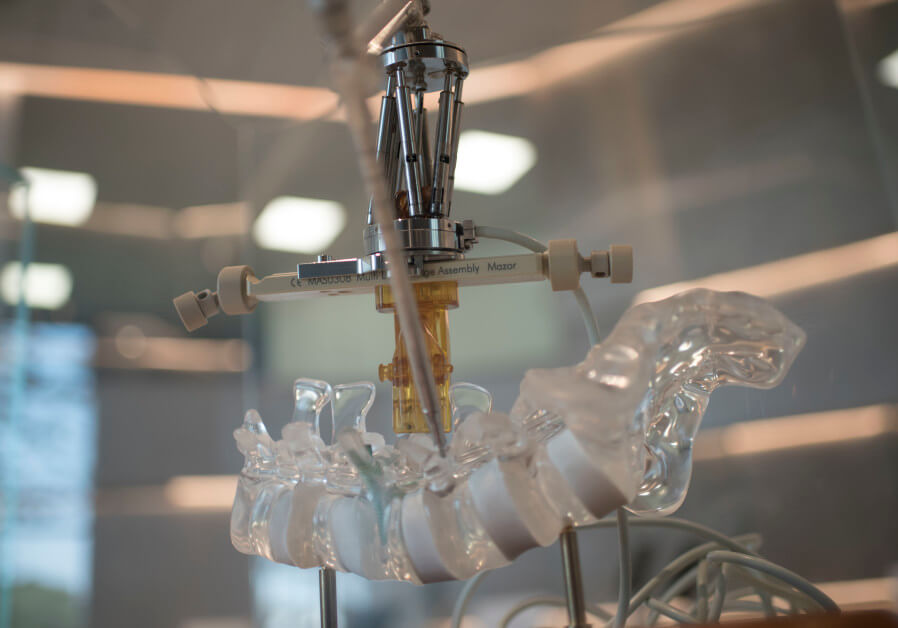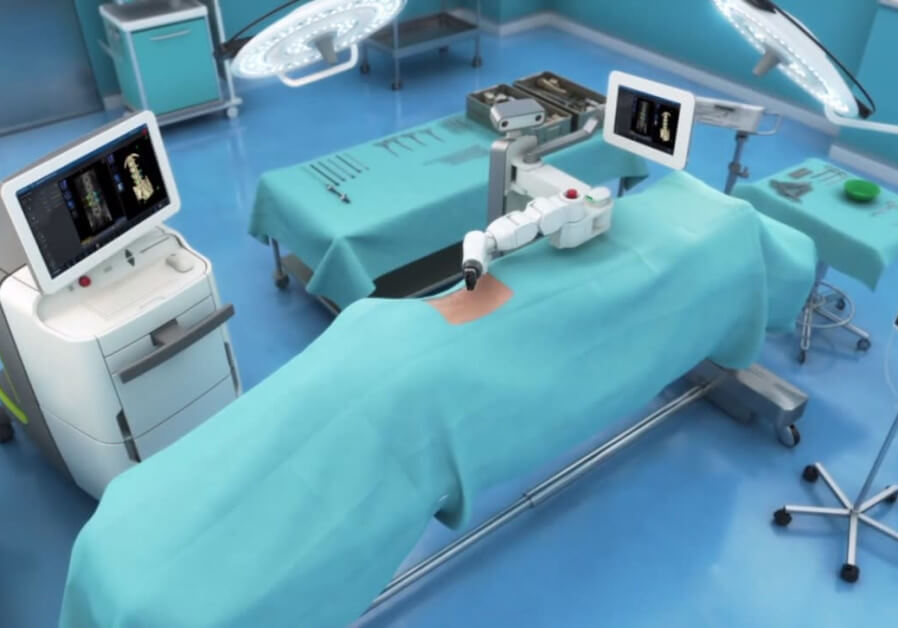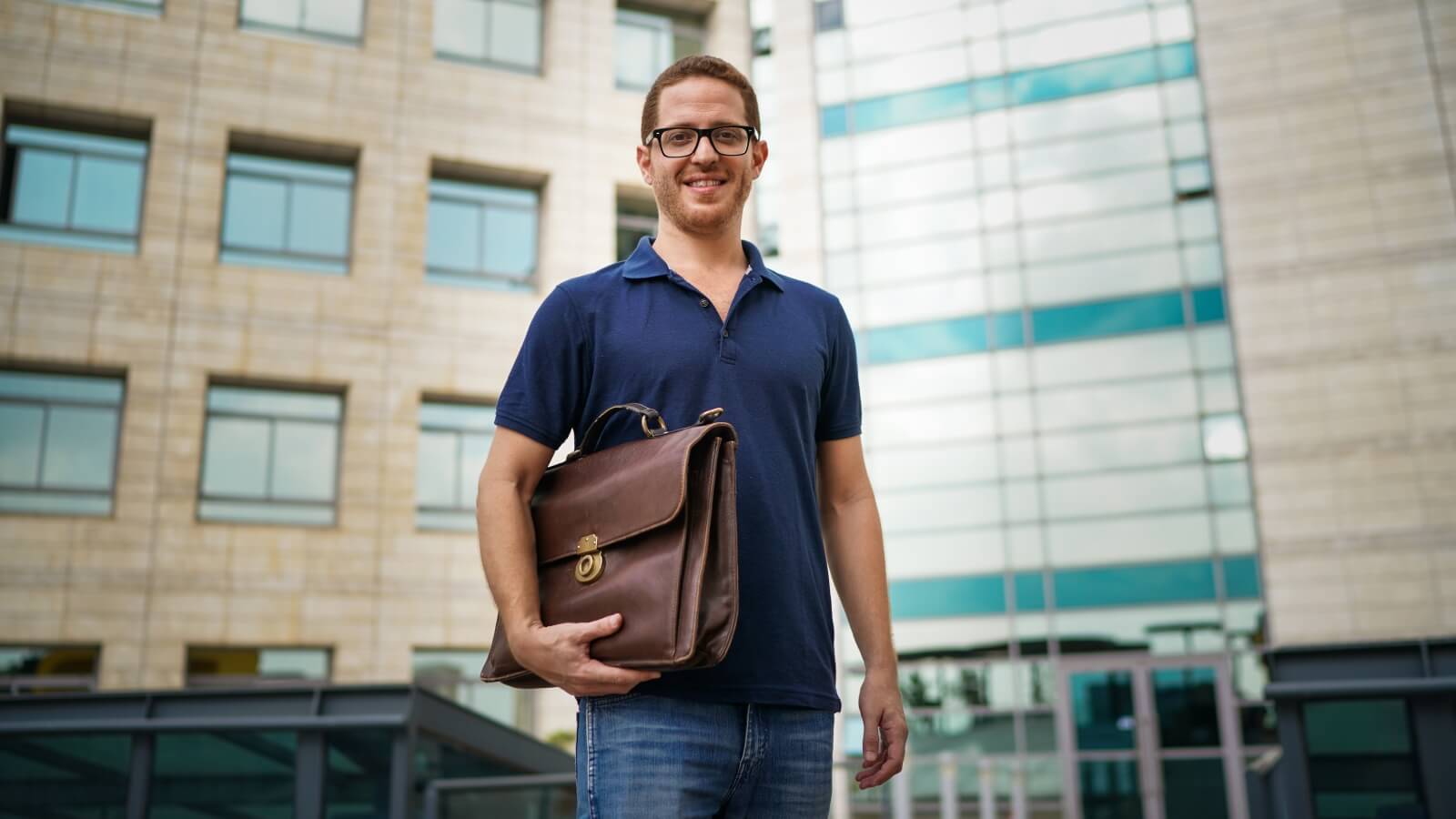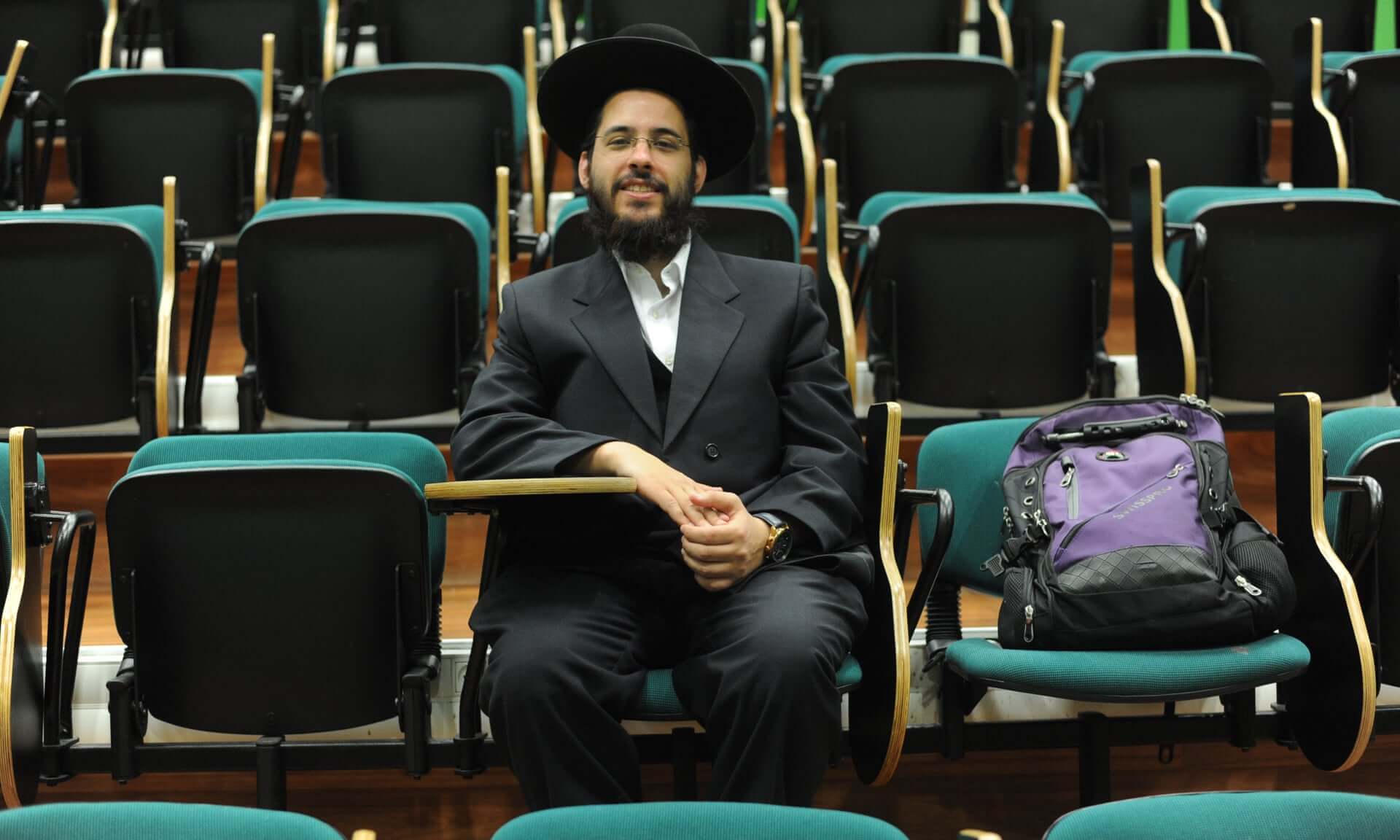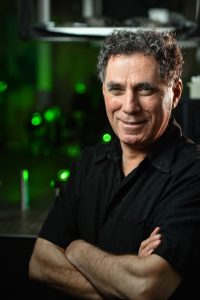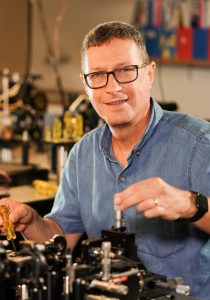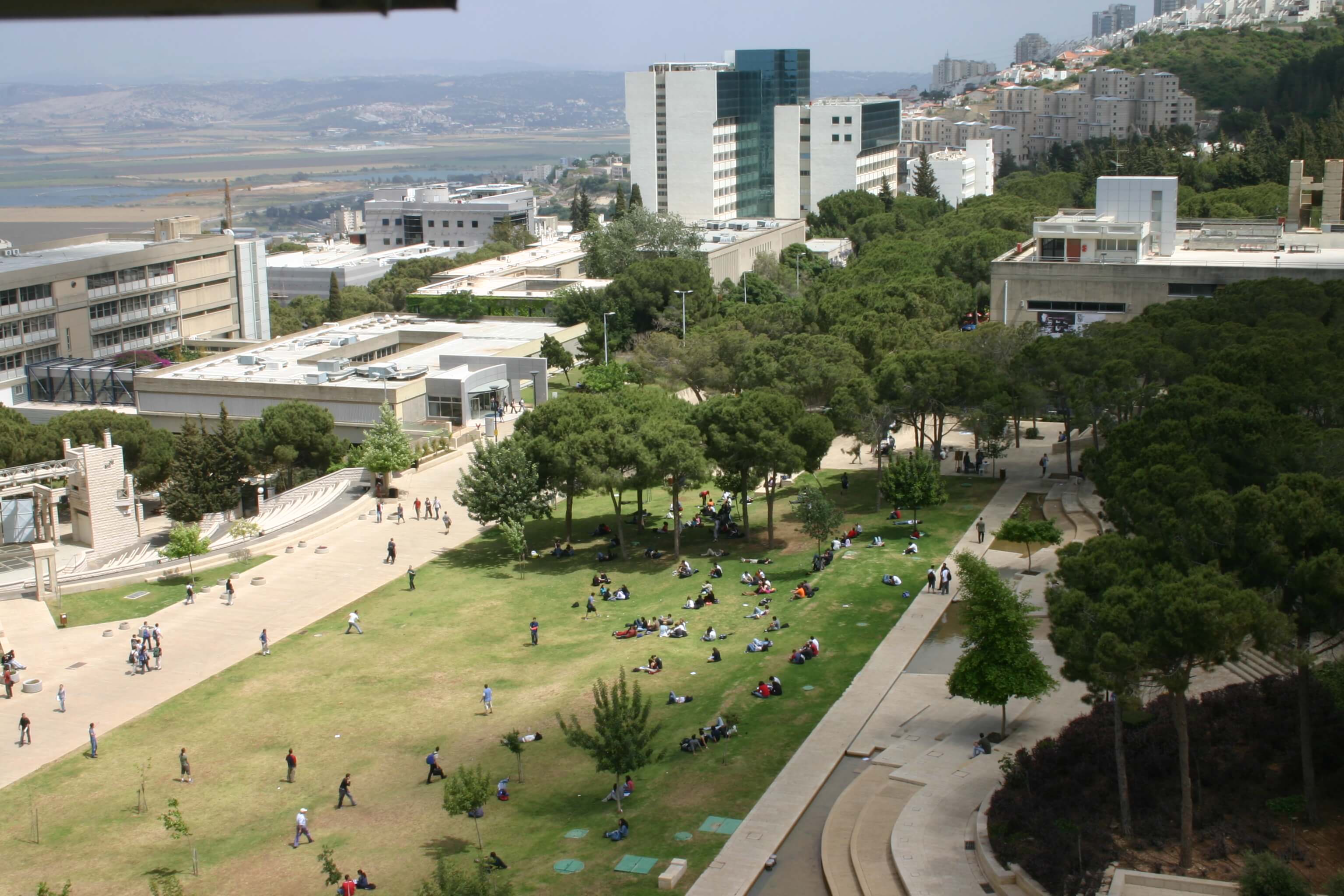Technion researchers have made immeasurable contributions to benefit the world.
Brain and spine surgeries are high-risk procedures that could have dire consequences if the surgeon is even one millimeter off target. Professor Moshe Shoham developed a robotic guidance system that helps perform these surgeries with pinpoint accuracy. The company he founded, Mazor Robotics, has done more than 7,000 successful surgeries and 50,000 implants.
And while battling cancer, Biotechnology and Food Engineering Professor Ester Segal spent endless days hooked up to IVs. We know how to make silicon chips for smartphones, she thought, so why not bring that high-tech know-how to cancer treatment? Working with medical researchers and clinicians in the Technion Integrated Cancer Center, she is developing nano-silicon carriers that could be ingested, injected or implanted to deliver chemotherapy over a period of weeks or months, doing away with IV drips, allowing patients to receive treatment while going about their daily lives.
These are just some of the immeasurable contributions that Technion researchers have made to benefit the world. To learn more about supporting the Technion, visit us or contact us directly at info@ats.org or 212.407.6300.
The t-hub will become a focal point for all entrepreneurial activities of the various Technion faculties, encouraging entrepreneurial thinking.
Article written by Shoshanna Solomon, published in The Times of Israel.
Researchers at the Technion successfully shrank malignant tumors in mice by manipulating the brain’s reward system.
Artificially activating the “reward system” in the brains of mice with two types of cancer led to a dramatic reduction in the size of their tumors, according to authors of a study conducted at the Technion-Israel Institute of Technology.
“The relationship between a person’s emotional state and cancer has been demonstrated in the past, but mainly in relation to negative feelings such as stress and depression and without a physiological map of the action mechanism,” said Assoc. Prof. Asya Rolls of the Technion Rappaport Faculty of Medicine, who supervised the study.
“Several researchers, for example Prof. David Spiegel of the Stanford University School of Medicine, showed that an improvement in the patient’s emotional state may affect the course of the disease, but it was not clear how this happened. We are now presenting a physiological model that can explain at least part of this effect,” she said.
The results were published in the journal Nature Communications by Rolls along with doctoral students Tamar Ben-Shaanan and Maya Schiller, as well as Hilla Azulay-Debby, Ben Korin, Nadia Boshnak, Tamar Koren, Maria Krot, Jivan Shakya and Michal A. Rahat, and Technion Asst. Prof. Fahed Hakim, medical director of the Scottish EMMS Hospital in Nazareth.
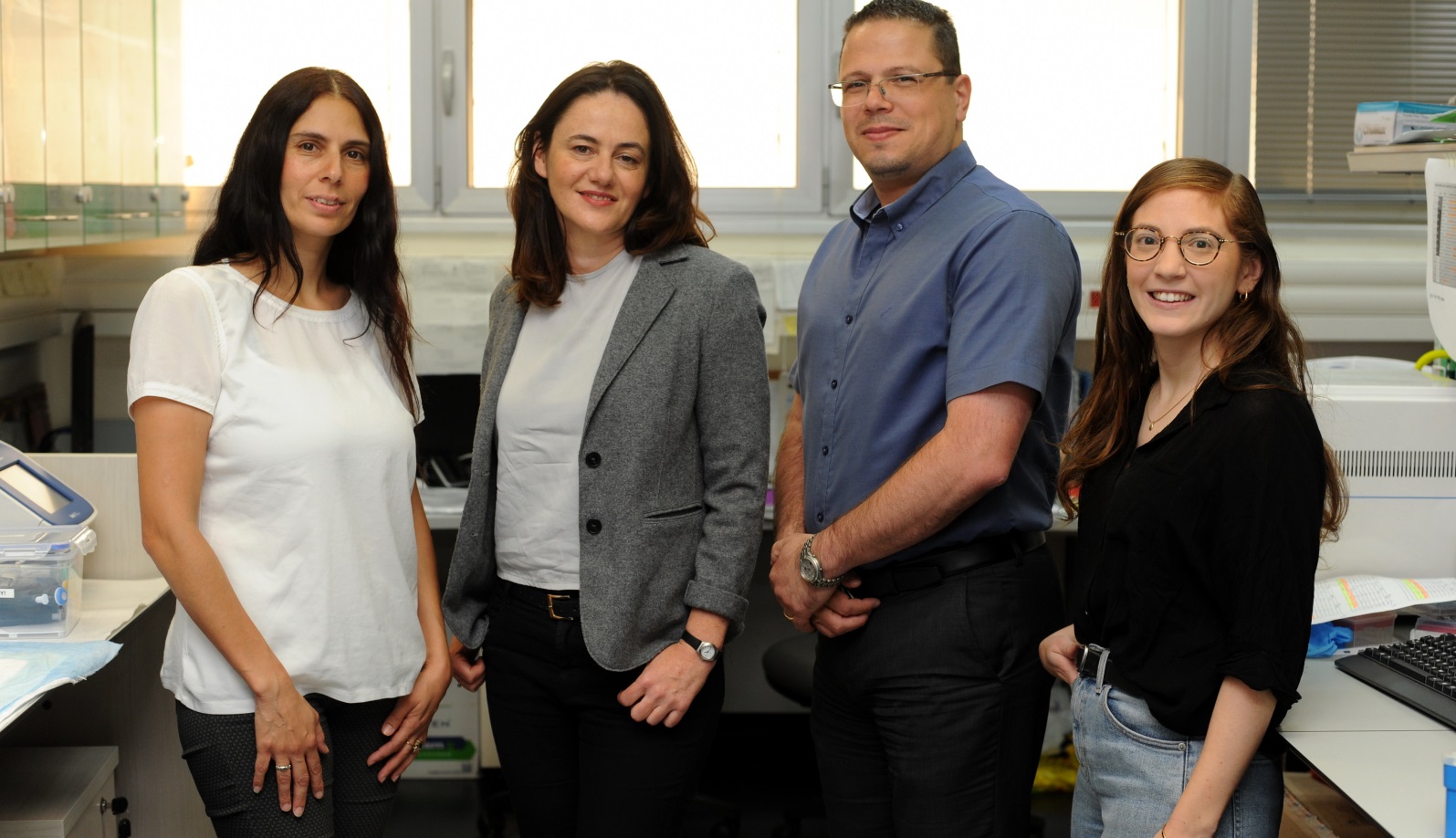
From left, Technion researchers Hilla Azulay-Debby, Prof. Asya Rolls, Prof. Hakim and doctoral student Maya Schiller. Photo by Rami Shlush, Technion Spokesperson’s office.
According to Hakim, “Understanding the brain’s influence on the immune system and its ability to fight cancer will enable us to use this mechanism in medical treatments. Different people react differently, and we’ll be able to take advantage of this tremendous potential for healing only if we gain a thorough understanding of the mechanisms.”
The authors emphasized that the study is preclinical and that they tested only two cancer models (melanoma and lung cancer) and only two developmental aspects – tumor volume and weight.
However, this breakthrough may allow doctors to realize the physiological role the patients’ mental state plays in the development of malignant diseases. By artificially activating different parts of the brain, in the future it might be possible to encourage the immune system to block development of cancerous tumors more effectively.
Rolls explained that although the immune system has been proven able to fight cancer effectively if given the right tools, “the immune cells’ involvement in cancerous processes is a double-edged sword, because certain components in these cells support tumor growth. This is done by blocking the immune response and creating an environment that is beneficial to growth.”
Rolls has been studying the brain’s effect on the immune system for several years. In a study she published in 2016 in Nature Medicine, she showed how the immune system can be stimulated to work more effectively by manipulating the brain’s reward system – which operates in positive emotional states and in anticipation of the positive.
The main breakthrough in the present study is the dramatic contraction of cancerous tumors in response to the activation of the brain’s reward system.
Rolls cautioned, however, that the findings are not necessarily applicable to all types of cancer and that the experiments have not been done on humans at this point.
The artificial manipulation that worked on mice “most probably works differently” in humans, she said, “especially because other systems are also involved. For example, stress may counteract these reward system effects.”
Rolls said it’s not as simple as thinking positively to get better. “People are very different in their reactions, and until we fully understand how this works, it merely offers a potential.”
The study was supported by the Adelis Brain Research Award, a $100,000 research grant won by Rolls in June 2017. The prize is intended to encourage excellence in the field of brain research in Israel and to translate the research into global impact for the benefit of all humanity.
Article published on Israel21c.
In 2000, Shoham approached the Technion’s incubator and started a company, today known as Mazor Robotics.
By Avi Jorisch, published in JPost on 28 September, 2018
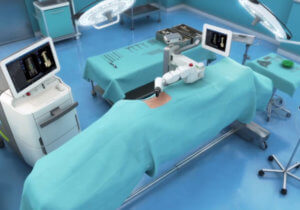
Medtronic, an Irish-American medical device company, announced last Friday that it was purchasing Israel’s Mazor Robotics for a hefty $1.64 billion, the biggest exit ever for an Israeli biotech company. Mazor’s signature piece of technology, a robotic-assisted procedure, represents the future gold standard of spine surgery, which is now poised to be implemented globally. Israeli innovations are improving the lives of millions of Americans and other people around the world, and this technology’s proven track record should encourage more American hospitals to adopt it.
Until about 15 years ago, spinal surgery was a lot like grasping in the dark. In order to even understand what procedure was necessary, doctors had to open up the spine. But a leading Israeli robotics professor, in conjunction with the Cleveland Clinic, developed a procedure that uses advanced artificial intelligence to help doctors perform previously unthinkable surgeries.
Prof. Moshe Shoham teaches at the Technion, the so-called MIT of Israel. In the late 1990s, Shoham began studying the spine because of its critical role in human mechanics, with the idea that the latest robotic technology could help doctors in the operating room. One of the first things he learned about spinal surgery is that it can be a nerve-racking experience not only for patients, but also for doctors, who often place large screws into small slots in the vertebrae by hand. If the doctor is slightly off, there is a high risk that the patient will be paralyzed for life. These types of procedures often require extensive tissue dissection and can result in blood loss and infection.
But Shoham believed that if a more accurate procedure could be developed, the probability of swift recovery would increase. While researching the issue, he was shocked to discover that during about two to three percent of spinal surgeries patients suffered nerve damage, which can result in weakness, muscle atrophy, twitching and paralysis. To his mind, that was unacceptably high.
In 2000, Shoham approached the Technion’s incubator – whose mission is to provide startups with operational support, management training and office space – and started a company, today known as Mazor Robotics. After four years of research and development, he began testing a robot capable of assisting surgeons in the operating room. He started with cadavers at the Sheba Medical Center in Israel and the Cleveland Clinic in the United States. Shoham and his team set out to prove that their invention could reduce operating-room time, minimize invasive surgeries, reduce the risk of infection and blood loss, and expedite recovery. The system wasn’t meant to replace surgeons, but to help them achieve better results.
By the end of 2004, not only did Mazor have a fully working product called SpineAssist, but it had been approved for sale by health authorities in Europe and the United States. “I was really astonished,” says Sho – ham. “We got it quite early.”
SHOHAM AND HIS PARTNERS created a unique imaging system. Prior to surgery, the patient undergoes a CT scan of the spine. On the day of the procedure, doctors take another two X-rays of the spinal column, one from the back and another from the side. A technician then merges the two sets of images using SpineAssist’s algorithms to create a three-dimensional blueprint. This allows surgeons to accurately see the spine in a way that was never possible before. After examining and approving the system’s recommendations, the doctor implants the screws using Shoham’s robot, which can accurately insert a spinal implant and reduce the danger of damaging nerves and vital organs. Finally, the system directs surgeons to the exact spot where they need to operate.
The holes for the screws can be placed within one millimeter of the desired location – about one-fifth the width of a human hair. This accuracy enables surgeons to reduce the chances of damage to the spinal cord and blood vessels during the operation. “With the robot we can be very precise,” says Dr. Andrew Cannestra, a neurosurgeon at Baptist Health in Jacksonville, Florida, who specializes in minimally invasive procedures. “It’s difficult to get the screws into the bone because there’s just not that much real estate… The robot allows us to put the largest screw possible into the smallest space.”
The system also has the added benefit of lowering radiation exposure during surgery for both patients and surgical teams. According to Mazor, use of the robot means that surgeons can now carry out procedures they would previously never have attempted – from spinal fusion to biopsies for suspected tumors. Medical procedures will never be the same.
Mazor has continued to win over doctors and patients, one procedure at a time. More than a decade after it received permission to sell its product in the United States and Europe, surgeons around the world are performing over a hundred operations a week using its technology. And not one patient who has undergone a procedure with Mazor’s robot has been crippled or experienced any kind of nerve damage.
There are currently just under 100 US hospitals utilizing Mazor’s artificial intelligence. The robot’s success speaks for itself, and every major medical center that performs spine surgery would be wise to integrate the technology as quickly as possible.
Avi Jorisch is the author of Thou Shalt Innovate: How Israeli Ingenuity Repairs the World (Gefen Publishing). He is also a Senior Fellow at the American Foreign Policy Council and the Israel Project.
New method will shorten the wait for novel drugs, and can lead to development of drugs that would not have been generated by existing methods.
Article by Brian Bloom, published on 20 September 2018 on Israel21c
Developing a new drug can cost billions of dollars and take a dozen or more years to bring to market. Two Israeli researchers have applied artificial intelligence (AI) and deep learning to shave time and money off the drug-discovery process.
Instead of searching for the appropriate molecules to use in a new medicine, as is done today, they enabled a computer to make smart predictions without human guidance.
Shahar Harel and Kira Radinsky at the Technion-Israel Institute of Technology fed into their computer system hundreds of thousands of known molecules as well as the chemical composition of all FDA-approved drugs up until 1950.
Aided by AI, the computer came up with new potential molecules by making sometimes unexpected correlations from within this massive sample.
“We are essentially presenting here an algorithm which addresses the creative stage of drug development – the molecule discovery stage,” Harel explains.
There are between1023 and 1060 molecules that show therapeutic potential. (By comparison, there are an estimated 1022 stars in the galaxy.) The typical drug-development process is shortened by focusing only on those molecules that feature the desired properties. That still leaves an enormous number.
When Radinsky and Harel instructed the system to propose 1,000 drugs based upon old drugs, they were surprised to discover that 35 of the suggestions generated by the system were in fact drugs approved by the FDA after 1950. That proved the system capable of learning to find promising drug candidates.
“What we’ve presented here is not only a means of streamlining existing methods, but also of entirely new drug development and scientific practice paradigms,” said Radinsky, who is an acknowledged data-scientist superstar.
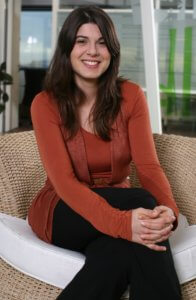
Kira Radinsky, visiting professor at the Technion and chief scientist at eBay Israel. Photo courtesy of Technion
Radinsky received her PhD in computer science from the Technion in 2013 and created a software tool with Microsoft Research head Eric Horovitz that can predict disasters such as the cholera outbreak in Angola. She subsequently founded SalesPredict. (The startup was acquired by eBay in 2016 and Radinsky became eBay Israel’s chief scientist.
Radinsky is also a visiting professor at the Technion. It was through this gig that she developed the system with Harel.
“This new development will accelerate and reduce costs of development of new and effective drugs, thereby shortening the time patients will have to wait for the drugs,” Radinsky said. “In addition, this breakthrough is expected to lead to development of drugs that would not have been generated with the conventional pharmacological paradigm.”
Traditionally, Haredi men have not joined the labour force. That is starting to change.
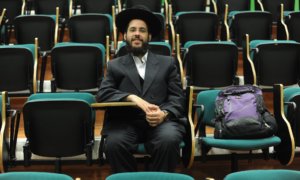
Medical student Yehuda Sabiner in class: ‘In the end 99% of people were encouraging me.’ Photograph: Rami Shlush
From the age of three, Yehuda Sabiner harboured a secret ambition to become a doctor. But it seemed unlikely to be fulfilled: he was raised in one of the strictest ultra-Orthodox Jewish communities in Israel.
His education was limited to religious study, first at a private school that barely taught mainstream subjects and later at a yeshiva, a religious school, where he spent 14 hours a day studying Jewish texts. Sabiner, a bright boy and an outstanding student, was earmarked to become a leading rabbi.
But he never forgot his dream. When he was 21 he confessed his ambition to his new wife. She was horrified: she had married him on the understanding that he would be a rabbinical leader. Also, he had no knowledge of science. But Sabiner’s yearning would not go away.
Now 28, Sabiner is embarking on the final year of his medical degree. He will be the first person born and raised in a Haredi community in Israel to become a mainstream doctor, and he plans to specialise in internal medicine.
Sabiner has benefited from a pioneering scheme at the Technion university in Haifa to draw young ultra-Orthodox, or Haredi, Jews from largely closed communities into mainstream education and then into the workforce.
The numbers are still tiny – about 60 out of a total student population of 10,000. “But the idea is to bring the number to 200 within five years, and to 400 within 10 years,” said Prof Boaz Golani, a vice-president of the university. “Engaging the Haredi community is important for Israel. Having a civil society where entire segments live in their own world and with little interaction with others is not healthy. It’s a recipe for tension and animosity.”
In 2017 the number of ultra-Orthodox Jews in Israel rose above one million for the first time, accounting for 12% of the population. By 2065 they are expected to make up a third of Israel’s population.
Traditionally, Haredi men are not economically active. Many spend their time in religious study, relying on state benefits to support their large families, which average almost seven children. But in recent years the Israeli government and educational institutions have taken steps to integrate the Haredi population into colleges and workforces.
“There was a concentrated effort launched a few years ago by the ministry of transport, which needed more engineers,” said Golani. If the Technion could get Haredi students on to its courses, jobs could be guaranteed.
“We knocked on the doors on yeshivas in Bnei Brak [an overwhelmingly ultra-Orthodox town near Tel Aviv]. We found a few rabbis ready to talk to us. The idea was to take young men who had the brain and intellect to meet the scientific admission criteria, and who were not perceived as chief rabbis of the future.
“We said we would not try to force any change of lifestyle of students, such as [strict] dress codes or praying. We kept a low profile.”
The Technion team identified 37 young men for a pre-university programme run from an anonymous rented warehouse in Bnei Brak. Over the course of 18 months, teachers tried to close a 12-year education gap to bring the Haredi men up to the standard of high school graduates.
They studied from 8am to 10pm. “It was like a bootcamp, very intensive,” said Golani. “But they brought from the yeshivas an ability to study hard, to focus, to apply logic, so we built on these skills.” At the end of the programme, about half were admitted to the Technion; they graduated this summer.
Bringing the students up to the required educational standard was not the only challenge. Gender segregation, a norm in Haredi communities, was a big issue, Golani said. “We told them upfront that we would not allow gender segregation on campus, no way. We suggested they arrive at class 10 minutes early and sit together, and they accepted that. We also told them that we have female professors, and we will not tell them they can’t teach certain students. They accepted that too.”
Another key issue was use of the internet. “So each [Haredi student] carries two phones: a kosher phone, with no apps, and a regular smartphone. On that there is an app which tracks the history of all addresses browsed and sends a report of every website visited to a designated person in their community.”
Some students have been ostracised by their communities. “One girl was boycotted by her friends. Someone else told me he was hiding for years, lying to his wife and family, telling them he was studying at another yeshiva when he was at the Technion.”
The university also runs programmes aimed at encouraging Arab students to enrol. “That tends to be easier because their communities are eager to see them gain top-quality education and so the community resistance is much lower,” said Golani.
It was essential to integrate “untapped resources” – meaning Arab-Israelis and ultra-Orthodox Jews – into the economy, he added. “The economy of Israel is largely based on the hi-tech sector. It’s the locomotive that carries the entire train of the Israeli economy. But we just don’t have enough people. Israel is a small country; we’re not India or China.”
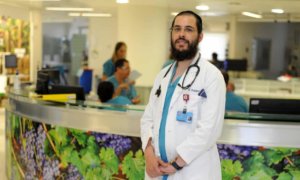
Sabiner is now in the final year of his medical degree. Photograph: Rami Shlush.
When Sabiner embarked on the challenge of becoming a doctor, initially he faced scepticism. “I was told it was impossible for me to catch up [academically] and to be accepted, that I would never make it as a doctor,” he said. But staff at the Technion “believed in me when no one else did”.
Article by Harriet Sherwood, published in The Guardian, 10 September 2018.
Under the auspices of the Helen Diller Center for Quantum Science, Matter and Engineering at the Technion, an interdisciplinary team of scientists has collaborated on groundbreaking research leading to the development of a new and innovative scientific field: Quantum Metamaterials. The findings are presented in a new joint paper published by the prestigious journal Science.
Haifa, Israel September 13th, 2018 – Two teams of scientists from the Technion-Israel Institute of Technology have collaborated to conduct groundbreaking research leading to the development of a new and innovative scientific field: Quantum Metamaterials. The findings are presented in a new joint paper published by the prestigious journal Science.
The study was jointly conducted by Distinguished Professor Mordechai Segev, of the Technion’s Physics Department and Solid State Institute and his team Tomer Stav and Dikla Oren, in collaboration with Prof. Erez Hasman of the Technion’s Faculty of Mechanical Engineering and his team Arkady Faerman, Elhanan Maguid, and Dr. Vladimir Kleiner. The two groups are affiliated with both the Helen Diller Center for Quantum Science, Matter and Engineering; and the Russell Berrie Nanotechnology Institute.

Seated (L-R): Prof. Erez Hasman and Dist. Prof. Mordechai Segev. Standing (L-R): Dr. Vladimir Kleiner, Elhanan Maguid, Arkady Faerman, Dikla Oren and Tomer Stav
The researchers demonstrated for the first time that it is possible to apply metamaterials to the field of quantum information and computing, thereby paving the way for numerous practical applications including, among others, the development of unbreakable encryptions, as well as opening the door to new possibilities for quantum information systems on a chip.
Metamaterials are artificially fabricated materials, made up of numerous artificial nanoscale structures designed to respond to light in different ways. Metasurfaces are the 2-dimensional version of metamaterials: extremely thin surfaces made up of numerous subwavelength optical nanoantennas, each designed to serve a specific function upon the interaction with light.
While to date, experimentation with metamaterials has widely been limited to manipulations using classical light, the Technion researchers have for the first time shown it is experimentally feasible to use metamaterials as the building blocks for quantum optics and quantum information. More specifically, the researchers have demonstrated the use of metamaterials to generate and manipulate entanglement – which is the most crucial feature of any quantum information scheme.
“What we did in this experiment is to bring the field of metamaterials to the realm of quantum information,” says Dist. Prof. Moti Segev, one of the founders of the Helen Diller Quantum Science, Matter and Engineering Center at the Technion. “With today’s technology, one can design and fabricate materials with electromagnetic properties that are almost arbitrary. For example, one can design and fabricate an invisibility cloak that can conceal little things from radar, or one can create a medium where the light bends backward. But so far all of this was done with classical light. What we show here is how to harness the superb abilities of artificial nano-designed materials to generate and control quantum light.”
“The key component here is a dielectric metasurface,” says Prof. Erez Hasman, “which acts in a different way to left- and right-handed polarized light, imposing on them opposite phase fronts that look like screws or vortices, one clockwise and one counterclockwise. The metasurface had to be nano-fabricated from transparent materials, otherwise – had we included metals, as in most experiments with metamaterials – the quantum properties would be destroyed.”
“This project started off in the mind of two talented students – Tomer Stav and Arkady Faerman,” say Profs. Segev and Hasman, “who came to us with a groundbreaking idea. The project leads to many new directions that raise fundamental questions as well as new possibilities for applications, for example, making quantum information systems on a chip and controlling the quantum properties on design.”
In their research, the scientists conducted two sets of experiments to generate entanglement between the spin and orbital angular momentum of photons. Photons are the elementary particles that make up light: they have zero mass, travel at the speed of light, and normally do not interact with each other.
In the experiments, the researchers first shone a laser beam through a non-linear crystal to create single photon pairs, each characterized by zero orbital momentum and each with linear polarization. A photon in linear polarization means that it is a superposition of right-handed and left-handed circular polarization, which correspond to positive and negative spin.
In the first experiment, the scientists proceeded to split the photon pairs – directing one through a unique fabricated metasurface and the other to a detector to signal the arrival of the other photon. They then measured the single photon that passed through the metasurface to find that it had acquired orbital angular momentum (OAM) and that the OAM has become entangled with the spin.
In the second experiment, the single photon pairs were passed through the metasurface and measured using two detectors to show that they had become entangled: the spin of one photon had become correlated with the orbital angular momentum of the other photon, and vice versa.
Entanglement basically means that the actions performed on one photon simultaneously affect the other, even when spread across great distances. In quantum mechanics, photons are believed to exist in both positive and negative spin states, but once measured adopt only one state.
This is perhaps best explained through a simple analogy: Take two boxes each with two balls inside – a red and a blue ball. If the boxes are not entangled then you can reach into the box and pull out either a red or a blue ball. However, if the boxes were to become entangled, then the ball inside the box could either be red or blue but will only be determined at the moment the ball in one box is observed, simultaneously determining the color of the ball in the second box as well. This story was initially related by the famous Nobel Laureate Erwin Schroedinger, presenting the scenario of a cat in a box, where the cat is both alive and dead until the box is opened.
Distinguished Prof. Mordechai Segev is the incumbent of the Robert J. Shillman Distinguished Research Chair; Prof. Erez Hasman is the incumbent of the Schlesinger Chair.
Click here for the paper in Science
Article published here.
Technion alumni star among the “Israeli Hottest Start-ups of 2018” list published in The Marker.
In July, The Marker published a list of Israel’s hottest start-ups of 2018 – 20 innovative companies which are expected to shape the future. Technion alumni fill senior positions in about 50% of the selected companies.
Tom Livneh, a Technion International-MBA program graduate, is the CEO and founder of VerbIT AI, a company that developed low-cost and rapid automatic transcription services. The VerbIT platform combines original algorithms, a speech-identification engine and thousands of human transcribers, who improve algorithm performance.
Asaf Yigal, a Viterbi Faculty of Electrical Engineering graduate, is one of the founders of Logz.io, which developed a technology that enables collection of large amounts of data, then used to perform complex analyses, presented in graphical and user-friendly formats.
Elram Goren, a graduate of the Faculties of Physics and Electrical Engineering at the Technion, is the CEO and founder of CommonSense Robotics, a company that develops programs and mini-robots for smart storage room management. This technology enables retailers to provide quick and effective deliveries to the client, without high manpower demands.
Eilon Reshef, a Faculty of Computer Science Technion alumnus who participated in the Technion’s Rothschild program for outstanding students, is the co-founder of Gong.io and manages the company’s technology. Gong developed a technology to improve the performance of sales people and organizations. The technology performs a computerized analysis of sales conversations and provides organizations with essential information from these calls – whether the product was presented properly, what the client was hesitant about, etc.
Eli Cohen, a Technion Industrial Engineering and Management Faculty alumnus, is a co-founder and VP of Donde Search – a company that develops search technologies that will enable fashion companies to identify trends, understand customer desires and provide them with personalized and focused recommendations.
Ido Priel, who earned an MSc in Systems Engineering at the Technion, is the co-founder and chief product manager at Space Pharma, a company that developed a platform for performing experiments in outer space. The mini-lab is launched to outer space and experiments can be remotely controlled. To date, the company has launched two such labs.
Dr. Yaniv Altshuler, who earned all of his advanced degrees at the Faculty of Computer Science at the Technion, is the co-founder and CEO of Endor, a platform which enables decision-makers to predict consumer behavior using an automatic prediction engine.
Several Technion alumni are in the Jacada corporate management team: directorate member Haim Shani, a Davidson Industrial Engineering and Management alumnus, Yoel Goldenberg, an Industrial Engineering and Management alumnus, and Jacques Tchenio, VP of Sales, who earned his MSc at the Faculty of Mathematics.
Yosef Bert, of blessed memory, was a Viterbi Faculty of Electrical Engineering alumnus, is the founder of Silentium, a company that is currently managed to Yoel Naor, developed an innovative noise-reduction technology for offices, bedrooms, and others. Currently, it is primarily used in the context of reduction of noises in the car.
The late Rami Feig, a Technion alumnus, was the founder of Hailo, which develops dedicated chips for artificial intelligence and big-data applications. The processor that the company is developing, will run artificial intelligence applications in connected computers, in drones, smart homes, and others. The late Avi Baum, the cofounder and chief technology manager at the company, is a Technion graduate, as is the serial entrepreneur Zohar Zisapel. Feig, Baum and Zisapel are Viterbi Faculty of Electrical Engineering graduates.
Article originally published here.
Parkinson’s disease is a progressive neurodegenerative disorder that affects dopamine-producing neurons in a specific area of the brain called substantia nigra. Parkinson’s symptoms include tremor, loss of smell and neuropsychiatric problems. However, many people aren’t diagnosed until their disease is well-advanced. Now, a team of scientists at Technion – Israel Institute of Technology has tested a device to detect early-stage Parkinson’s disease from the breath of patients.
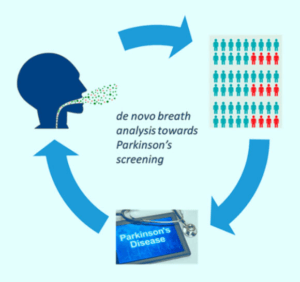
Early diagnosis of Parkinson’s disease is important because it affects the choice of therapy and is subject to a relatively high degree of error. Image credit: Finberg et al, doi: 10.1021/acschemneuro.8b00245.
About 60,000 Americans are diagnosed with the movement disorder each year. But by the time most people experience symptoms, they have already lost many of the dopamine-producing neurons affected by the disease.
Diagnosing Parkinson’s at an earlier stage could help these patients begin neuroprotective therapy sooner.
To this end, Technion researcher John Finberg and co-authors previously developed a device with an array of 40 sensors based on gold nanoparticles or single-walled carbon nanotubes.
Each sensor had a different chemical attached that could bind certain volatile molecules in the breath, and this binding changed the electrical resistance of the sensor.
The device detected differences in the exhaled breath of people already being treated for Parkinson’s disease and healthy controls.
Now, the team wanted to see if the device could detect differences in the breath of patients with early-stage, not-yet-treated Parkinson’s disease.
The scientists tested the device on the exhaled breath of 29 newly diagnosed patients who had not yet begun taking medication for their illness.
When comparing the sensor output to that of 19 control subjects of similar age, they found that the array detected early Parkinson’s disease with 79% sensitivity, 84% specificity and 81% accuracy, which was better than a diagnostic smell test and almost as good as an ultrasound scan of the brain.
“Although the device needs to be improved and validated by larger studies, it has potential as a small, portable system to screen at-risk individuals without the need for highly-trained specialists,” the researchers said.
The team’s results appear in the journal ACS Chemical Neuroscience.
CBD Oil for Parkinson’s Disease
_____
John P.M. Finberg et al. Sensor Array for Detection of Early Stage Parkinson’s Disease before Medication. ACS Chem. Neurosci, published online July 10, 2018; doi: 10.1021/acschemneuro.8b00245
Article published on July 27, 2018 here.


